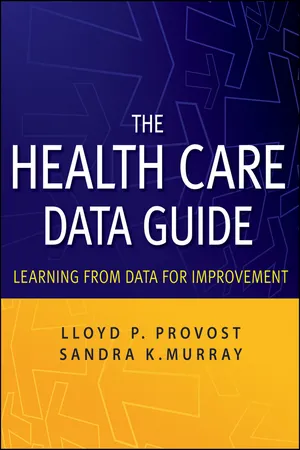
The Health Care Data Guide
Learning from Data for Improvement
- English
- ePUB (mobile friendly)
- Available on iOS & Android
The Health Care Data Guide
Learning from Data for Improvement
About this book
The Health Care Data Guide is designed to help students and professionals build a skill set specific to using data for improvement of health care processes and systems. Even experienced data users will find valuable resources among the tools and cases that enrich The Health Care Data Guide. Practical and step-by-step, this book spotlights statistical process control (SPC) and develops a philosophy, a strategy, and a set of methods for ongoing improvement to yield better outcomes.
Provost and Murray reveal how to put SPC into practice for a wide range of applications including evaluating current process performance, searching for ideas for and determining evidence of improvement, and tracking and documenting sustainability of improvement. A comprehensive overview of graphical methods in SPC includes Shewhart charts, run charts, frequency plots, Pareto analysis, and scatter diagrams. Other topics include stratification and rational sub-grouping of data and methods to help predict performance of processes.
Illustrative examples and case studies encourage users to evaluate their knowledge and skills interactively and provide opportunity to develop additional skills and confidence in displaying and interpreting data.
Companion Web site: www.josseybass.com/go/provost
Frequently asked questions
- Essential is ideal for learners and professionals who enjoy exploring a wide range of subjects. Access the Essential Library with 800,000+ trusted titles and best-sellers across business, personal growth, and the humanities. Includes unlimited reading time and Standard Read Aloud voice.
- Complete: Perfect for advanced learners and researchers needing full, unrestricted access. Unlock 1.4M+ books across hundreds of subjects, including academic and specialized titles. The Complete Plan also includes advanced features like Premium Read Aloud and Research Assistant.
Please note we cannot support devices running on iOS 13 and Android 7 or earlier. Learn more about using the app.
Information
- Describe the Model for Improvement
- Illustrate use of the Plan, Do, Study, Act Cycle for testing and implementing changes
- Introduce graphical methods to learn from data
- Describe a typical health care improvement project
- Enumerate the methods and tools used to support improvement

- Is useful for both process and product improvement
- Is applicable to all types of organizations
- Is applicable to all groups and levels in an organization
- Facilitates the use of teamwork to make improvements
- Provides a framework for the application of statistical tools and methods
- Encourages planning to be based on theory
- Emphasizes and encourages the iterative learning process
- Provides a way to empower people in the organization to take action
- Provides leaders a mechanism to think through all aspects of the proposed effort
- Aids in selection of the team to make the improvements
- Reduces variation in activities from the original purpose
- Helps in the selection of particular processes or products for study
- Empowers individuals to make cha...
Table of contents
- Cover
- Contents
- Title
- Copyright
- Dedication
- Figures, Tables, and Exhibits
- Preface
- The Authors
- Part I: Using Data for Improvement
- Part II: Advanced Theory and Methods with Data
- Part III: Applications of Shewhart Charts in Health Care
- Part IV: Case Studies
- Index
- Shewhart Chart Selection Guide